Those of us who walk along any of the multitude of Camino paths refer to ourselves as pilgrims. We see ourselves as being a current-day extension of the long line of women and men, of all stations and lands of origin, who have made pilgrimages to Santiago de Compostela since the 9th century. It is at Santiago that legend and faith state the human remains of Saint James the Great, one of Christ’s earliest disciples, are preserved in a reliquary at the cathedral bearing his name. While the historic origins for undertaking such a long journey on foot were based on the tradition of earning indulgences to compensate for committed sins, the modern motives vary so widely that I’m reluctant to guess. Many of those I’ve met along “The Way” (the literal English for “Camino”) were there as true Catholic pilgrims, seeking a deeper connection to their faith. Others were seeking a connection more to themselves – a type of self discovery – spiritual but not bound to Catholic dogma. Another category would be the adventure tourist looking to experience an intimate connection to a land, culture and history in a manner that no drive-by tourism can ever offer. And there are more motives.


Yes, I refer to myself as a pilgrim and attempt as much as possible to adhere to the spirit of that label, but I’m not a true pilgrim in all respects. My own motive is somewhere in the second category… self-discovery by challenging myself to do something difficult, thereby testing my stamina and my limits, both physical and emotional. But my adherence to the “pilgrim” label break down fairly often, especially at the end of each day. True pilgrims seem to take pride in quartering overnight in hostels where bunk beds, tight spaces and shared bathrooms are the norm. I’ve done that and admittedly have even enjoyed it, especially when I was with newly-made friends where, like kids’ sleepovers, you can sit up late in the dark and exchange stories and ideas. But on this Camino, the Invierno, I knew before setting out that I’d likely be very much alone. It didn’t seem appealing to sleep by myself in a lower bunk in a large room where the other bunks are empty. I’d already experienced that weird sensation two years earlier on the southern (before Porto) section of the Portugues. So my plan all along had been to book ahead, to fix a daily destination and to know that I’d have private quarters to spend the night, recharging myself for the next day’s long walk.


The night before starting the second week was a special treat, as I described in the prior post, a long restful sleep in one of Spain’s renowned “Paradores,” a convent that was now a luxury hotel, sitting high above the small city of Monforte de Lemos. While sleep was a highlight, a wonderful massage followed by a steak dinner (as opposed to the bread and ham I’d eaten most nights to say nothing of the stack of Pringles the night before) made the hotel stay especially memorable. So, on the morning kicking off week #2 I sleep in, knowing that it would be the second day in a row where I only had to cover ten miles. But first I indulge in a breakfast buffet, feeling more the tourist than the pilgrim. That ends soon as I pull on my backpack and begin the slow, careful descent of the very steep hill that towers over the city.
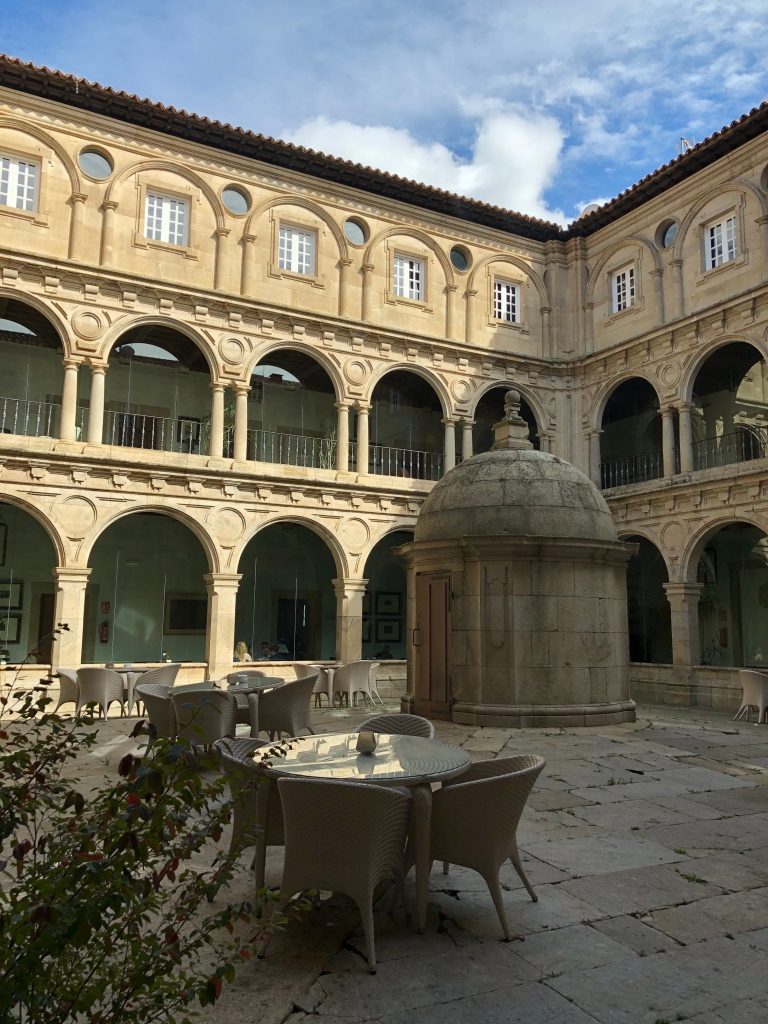
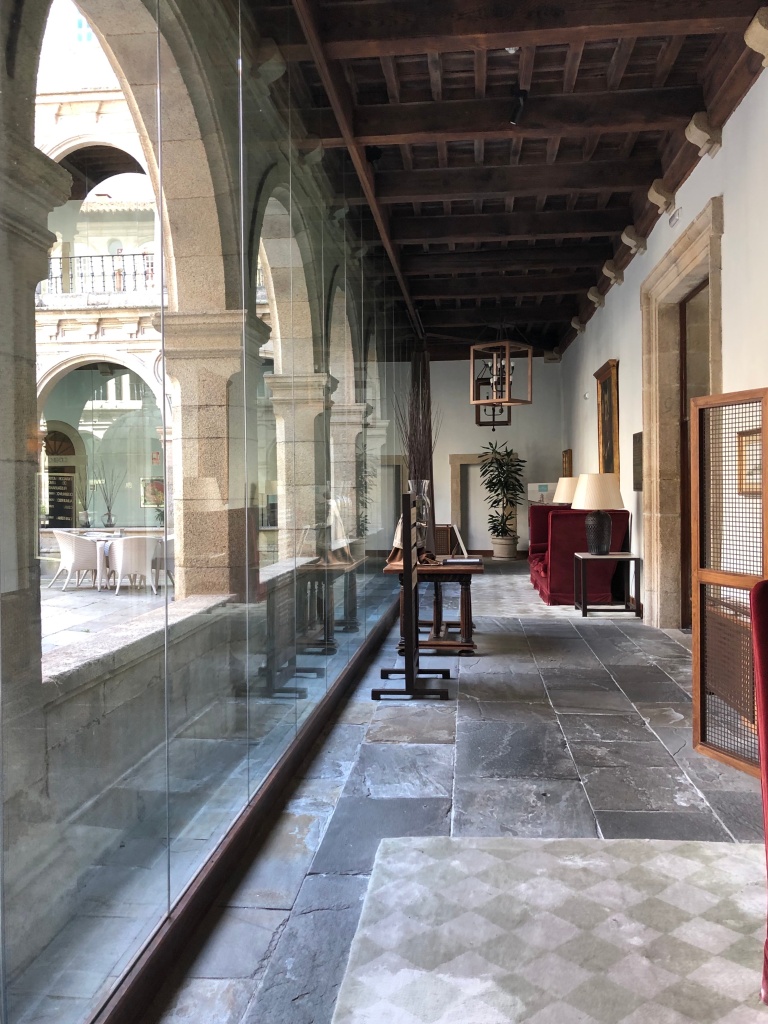
It is mid-morning now and when I reach the city center it’s busy with shoppers, a few tourists, a lively coffee shop vibe, plus one lonely pilgrim. I thought that perhaps here – one of the larger places I’d crossed – I might encounter someone else burdened with a backpack and hiking poles, but not a one in sight. I’m tempted to enjoy one more “cafe con leche” before moving on, in part to people-watch since I’d seen so few in the past week, but I’ve already had two back at the hotel, so I move on. The staple dish of Galicia is “pulpo,” octopus, so I can’t resist snapping a photo of the bucket of these tentacled creatures – decapitated by now – being prepared for the pot in one of the outdoor “pulperias” that line the market street. By lunchtime – 1pm – they’ll be ready.




Then I cross the classic Roman bridge that spans the Rio Cabe, beyond which sits the majestic “Convento das Clarisas de Monforte,” another repurposed convent that now serves as a history and art museum. A short way further on is the attractive contemporary “Casa de Concello,” the city hall, and then I walk along a tidy residential street exhibiting a variety of interpretations of classic regional architecture featuring the 1st floor (in the US we say 2nd floor) balcony or enclosed sun-room. At the end of that long street, as it transitions into the outskirts, stands a monument to the medieval pilgrim. He carries a staff topped by a cross as a walking aid, and attached to it are the scallop shell emblem of Saint James (one is attached to my pack as well) and a drinking gourd for his water. The monument is a reminder to this modern-day counterpart that the luxury of the night before was unimaginable to him a thousand years ago.
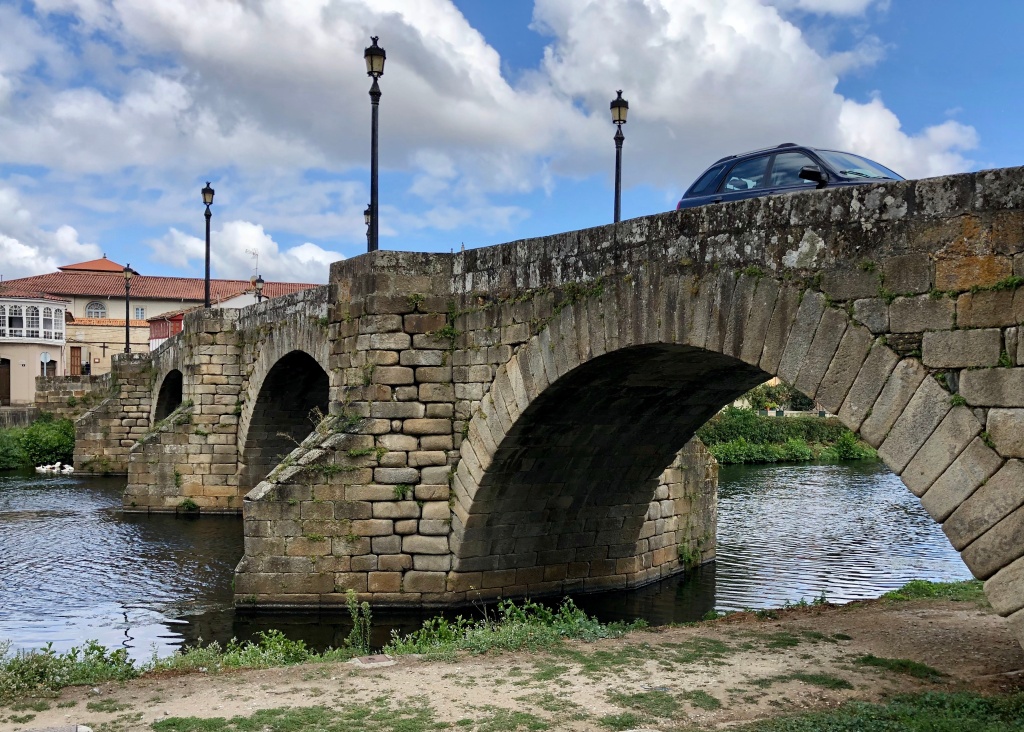
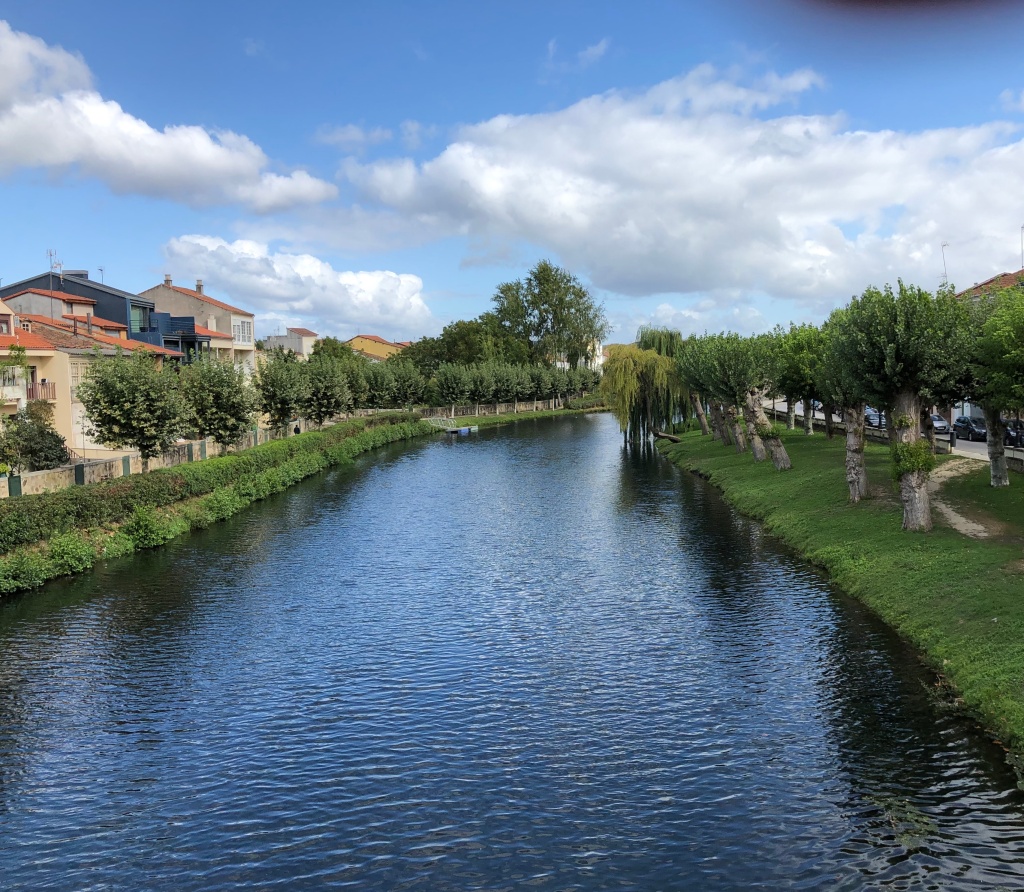



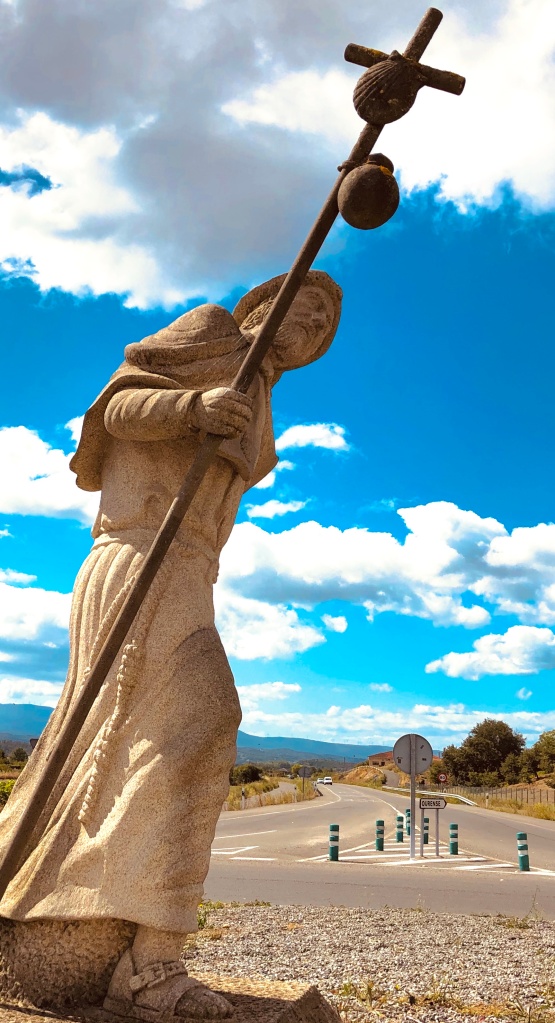
The walk beyond Monforte is unremarkable both in landscape and distance. The terrain gently undulates under a radiantly blue sky dotted by billowy clouds, and the midday temperature rises to the low 80s. It’s farms and vineyards now, with cows grazing contentedly and sheep lazing in the shade. No one pays any attention to the sole pilgrim passing by, even as I stop to take photos.
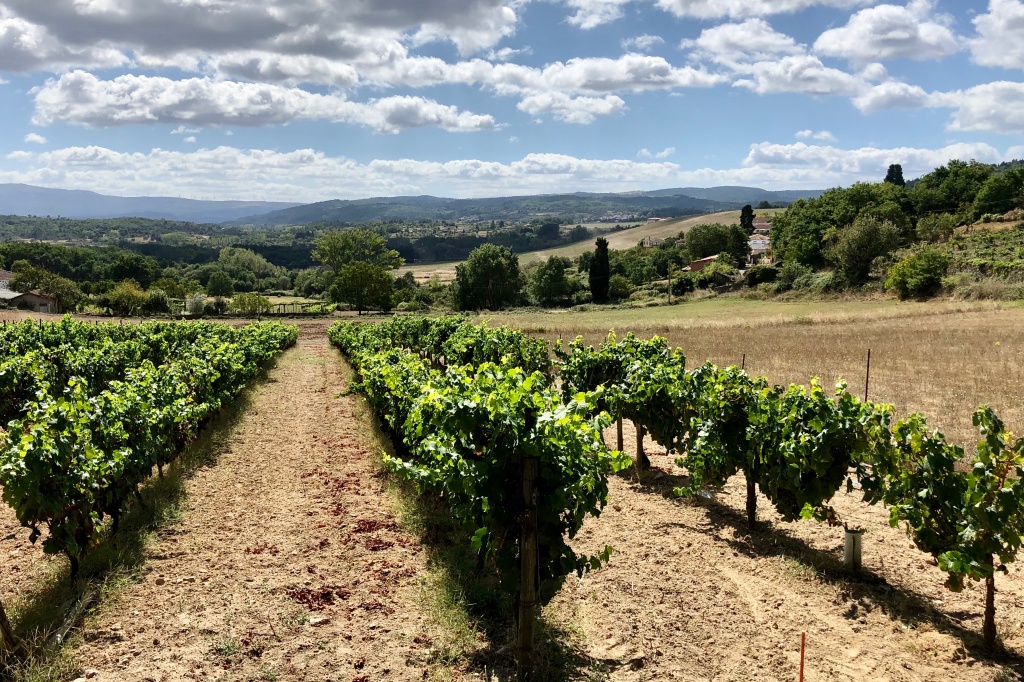

By mid-afternoon, only five hours from the Monforte hilltop, I spot what my map tells me is tonight’s lodging, the “Casa dos Muros,” the House of Two Walls, a wine-country B&B. It’s guarded by a friendly dog of intimidating size, and not only does it have two walls, but it has countless doors, most of which I try to enter without success. Finally, I enter one and call out “Hola.” A minute or so later friendly Bernie emerges out of the door that I presume to be the private residence. He’s exceedingly warm and gracious, insisting on guiding me through the maze of the place before he takes me to my cozy room. It’s such a crazy layout that I only hope I can find my way through the rambling house again. Fortunately I can. There’s a spacious and inviting sunroom, one of many sitting areas, where I settle down, first to call Nancy back home and then to read for a while before my heavy eyelids shut things down for a couple of hours.

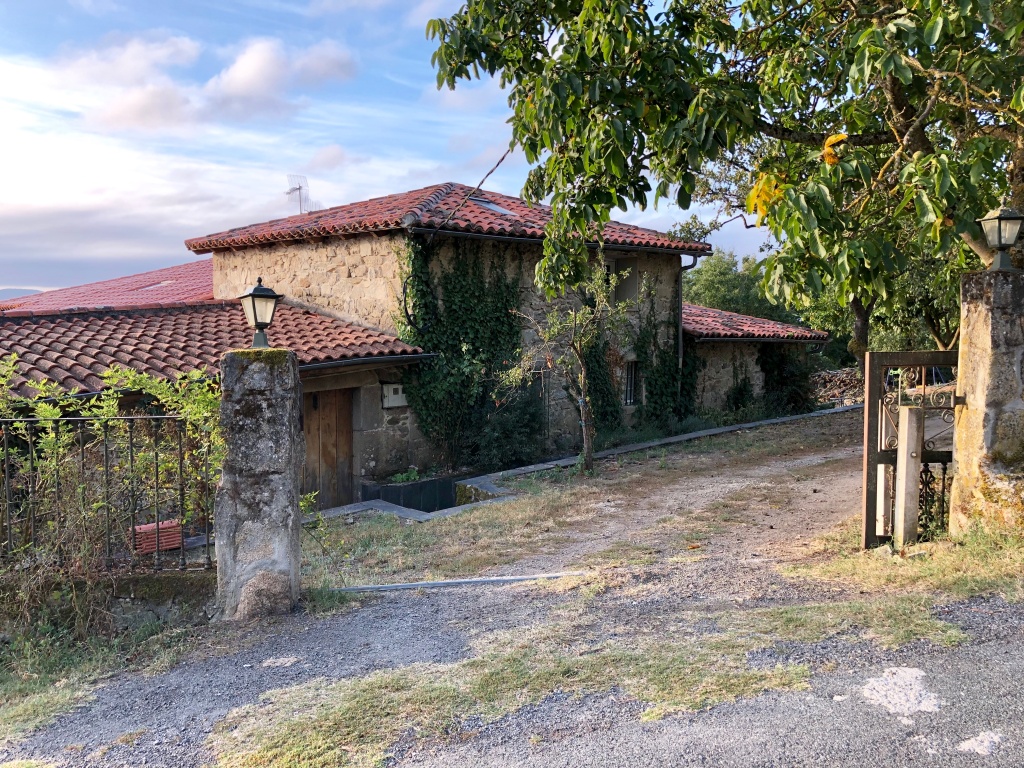


When I wake up a library of books tempts me to browse. It includes a photo album that appears to show the Casa dos Muros at various stages in its long existence. Bernie tells me later that it was his wife’s family’s farm house for several generations and that when he and his wife inherited it, the state of repair of the place was dismal. I had seen that in some of the photos. It was obvious from what I was seeing first-hand that they had restored it beautifully, leaving intact much of what had made the place unique.
Once again, I may have been a pilgrim by label, but at that moment, second day in a row, I was relishing my short-term status as a tourist. Also, it suddenly dawns on me that by having had some conversation with Bernie, who speaks very passable English, I feel less isolated from others than I’d been for the entire previous week… conversation has the power to connect people. The evening ends with a hearty country meal, followed by a good night’s sleep. Tomorrow has to start early as several challenging days lie ahead.



Beautiful!
LikeLike
Wonderful post, Tony! The photos really give an excellent window into your world of daily walking and it’s great you got to enjoy a bit more upscale lodgings this trip. The dichotomy of pilgrim/tourist is an a fascinating one, especially in the interactions with the people whose daily lives you intersect. (BTW, I just read your post at Pumpkin Tales, which I’m sure you remember, and it’s “Taco Tuesday” . . .
LikeLike
Many thanks for this
I’ve been waiting for your post for a while now!!!
LikeLike
Your story is so captivating sometimes I forget that it is YOUR experience and not just a story. I marvel at your detailed, poetic recollections. Love the photos. They give reality to the tale. Thank you for posting.
LikeLiked by 1 person
Great chapter!
Best Regards, Bruce
208-805-2923
>
LikeLike
A really enjoyable series of posts!
LikeLike
Thank You. Writing about the experiences is an enjoyable way to relive them and keep them forever.
LikeLiked by 1 person
Agreed! You’ve written wonderfully and the accompanying photos really paint a vivid picture!
LikeLike